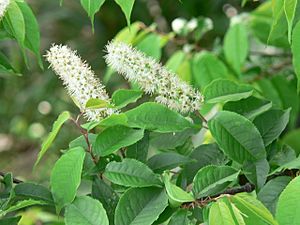Prunus grayana facts for kids
Quick facts for kids Prunus grayana |
|
|---|---|
 |
|
| Scientific classification | |
| Synonyms | |
|
Prunus grayana, also known as the Japanese bird cherry or Gray's bird cherry, is a type of bird cherry tree. It comes from Japan and China. You can find it growing in mountains at heights of 1,000 to 3,800 meters (about 3,300 to 12,500 feet). This tree likes sunny spots and soil that is moist but drains well.
This tree is a small deciduous tree, which means it loses its leaves every year. It can grow to be 8 to 20 meters (about 26 to 65 feet) tall. The trunk is thin and has smooth bark that is grey to purple-grey. You might see horizontal brown marks called lenticels on the bark. If you cut the bark, it has a strong smell.
The leaves are shaped like an oval or egg, about 4 to 10 centimeters (1.5 to 4 inches) long. They have jagged edges with tiny pointed tips. The lowest teeth on a leaf have two small glands.
Flowers and Fruit
The Japanese bird cherry produces many small, white flowers. These flowers grow on long clusters called racemes, which are about 5 to 8 centimeters (2 to 3 inches) long. Each flower is about 7 to 10 millimeters (0.3 to 0.4 inches) wide and has five white petals. The flowers appear in the middle of spring, after the leaves have grown.
After the flowers, the tree grows small fruits. These fruits are called drupes, which are like tiny cherries. They are about 8 millimeters (0.3 inches) across. At first, they are green, then they turn red, and finally they ripen to black in the middle of summer.
This tree is very similar to another tree called Prunus padus, or the common bird cherry. The main differences are the pointed tips on the leaf edges of Prunus grayana (which are blunt on P. padus). Also, the flowers of Prunus grayana have a longer style.
What the Tree is Used For
The Japanese bird cherry is quite useful! In Japan, people eat the flowers, fruit, and seeds. The fruit can even be preserved with salt to make a special dish called Anningo.
The bark and roots of the tree can be used to make a green dye. The wood from this tree is very hard and can be split easily. Because of its strength and beauty, it is often used to make cabinets and other decorative items.
How it Got its Name
This tree was first described in 1864 by a scientist named Miquel. He called it Prunus padus var. japonica. Later, in 1883, another scientist named Maximowicz studied the tree more closely. He decided it was a unique species and named it Prunus grayana after a botanist named Asa Gray.
See also
 In Spanish: Prunus grayana para niños
In Spanish: Prunus grayana para niños

